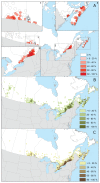The increasing risk of Lyme disease in Canada
- PMID: 26130829
- PMCID: PMC4466818
The increasing risk of Lyme disease in Canada
Abstract
There is an increasing risk of Lyme disease in Canada due to range expansion of the tick vector, Ixodes scapularis. The objectives of this article are to i) raise public awareness with the help of veterinarians on the emerging and expanding risk of Lyme disease across Canada, ii) review the key clinical features of Lyme disease in dogs, and iii) provide recommendations for veterinarians on the management of Lyme disease in dogs.
Risque accru de maladie de Lyme au Canada. Il existe un risque grandissant de maladie de Lyme au Canada en raison d’un élargissement de la portée de la tique vectrice, Ixodes scapularis. Les objectifs du présent article consistent à i) rehausser la sensibilisation du public avec l’aide des vétérinaires quant au risque émergent et grandissant de la maladie de Lyme au Canada, ii) examiner les principales caractéristiques cliniques de la maladie de Lyme chez les chiens et iii) présenter des recommandations aux vétérinaires pour la gestion de la maladie de Lyme chez les chiens.(Traduit par Isabelle Vallières).
Figures


References
-
- Little SE, Heise SR, Blagburn BL, Callister SM, Mead PS. Lyme borreliosis in dogs and humans in the USA. Trends Parasitol. 2010;26:213–218. - PubMed
-
- Littman MP. Lyme nephritis. J Vet Emerg Crit Car. 2013;23:163–173. - PubMed
-
- Leighton PA, Koffi JK, Pelcat Y, Lindsay LR, Ogden NH. Predicting the speed of tick invasion: An empirical model of range expansion for the Lyme disease vector Ixodes scapularis in Canada. J Appl Ecol. 2012;49:457–464.
-
- Koffi JK, Leighton PA, Pelcat Y, et al. Passive surveillance for I. scapularis ticks: Enhanced analysis for early detection of emerging Lyme disease risk. J Med Entomol. 2012;49:400–409. - PubMed
MeSH terms
LinkOut - more resources
Full Text Sources
Medical
